Water floor heating convectors: types, manufacturers, how to choose the best
When arranging heating in a house, everyone strives to create the most efficient system that would maintain an optimal microclimate in the room, and at the same time be economical.
Water floor heating convectors, which are distinguished by an aesthetic design and do not cause installation difficulties, cope well with these tasks.
Next, we will talk about the operating features and types of floor convectors. In addition, in the article you will find recommendations for choosing heating equipment.
The content of the article:
Characteristics of floor-standing water convectors
Heating devices offered by domestic and foreign manufacturers differ significantly in appearance, material, variety of models and, of course, cost.
To choose the appropriate option for your home, you will need to take a closer look at convector-type water heating equipment.
Design and principle of operation of the device
The floor convector has an oblong galvanized body 1-2.5 m long. One or more pipes in a protective casing are placed inside, performing the function of a heat exchanger. They are made of brass or copper and connected to aluminum plates. These materials are chosen for a reason - they heat up quickly and give off heat.
Thermal energy spreads due to the circulation of air masses. Corrugated tubes are connected to the side or end inputs in the system, through which water is supplied to heat the heat exchanger.
The air enters the holes made in the lower part of the device, contacts the heating element and, increasing in volume, exits into the room through the upper lattice panel.
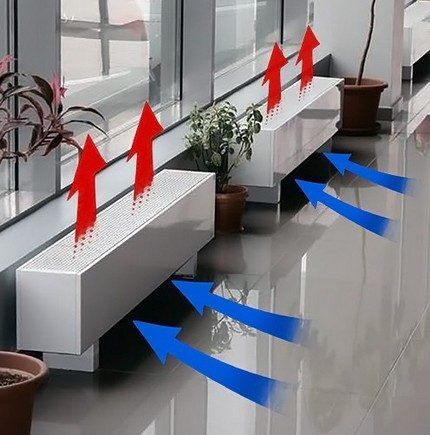
The heating process is carried out continuously. One cycle takes approximately 15 minutes. The convector heating system is almost silent - the sounds produced do not exceed 20-23 dB.
Types of floor convectors
There are several types of underfloor water heating devices on the market. They differ in heating method and purpose.
Conventionally, there are two types of equipment:
- with natural convection;
- with forced convection.
The first option provides for natural convection in the devices according to the classical scheme: air enters from below, passes through the heat exchanger and is pushed into the room.
The efficiency depends on the traction force and the size of the device. The longer the length, the higher the power. Devices with natural convection can serve as an additional source of heat and form a heat shield near windows.
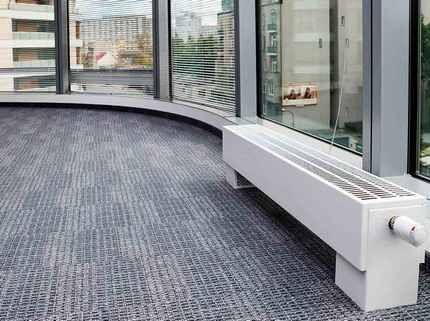
Models operating on the principle of forced convection are additionally equipped with a fan, which increases the efficiency of the device. It speeds up the heating process by pumping air and pushing it more intensively into the room.
The power of such equipment is determined by the fan rotation speed.

Devices with forced convection are used in both combined and autonomous heating systems of residential apartments, houses, offices, and retail spaces.
Most manufacturers' product lines include models designed for particularly wet areas.
Advantages and disadvantages of devices
With the help of floor-type water convectors, you can organize a heating system that provides fast, uniform and high-quality heating of rooms of different sizes. And this is far from the only advantage.
This equipment is different:
- stylish design and compact dimensions;
- fire safety;
- ease of installation and maintenance;
- economical energy consumption;
- low heating temperature of the coolant;
- the possibility of forming a reliable thermal curtain;
- long service life.
The equipment allows you to create and maintain an optimal comfortable climate and control the temperature using thermostat.
Most manufacturers integrate special cleaning systems into floor convectors. They destroy viruses, bacteria and prevent the spread of infections in the air.
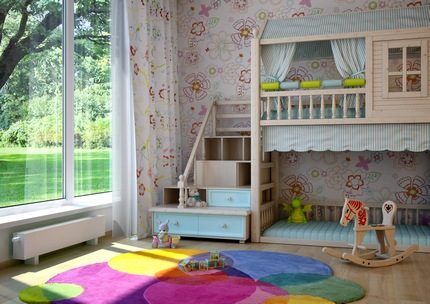
The devices also have disadvantages. Firstly, they are incompatible with artificial ventilation. Secondly, convection currents provoke excess dust.
In addition, it is not advisable to install convectors in rooms where the ceiling height is below 2.2 meters. This is due to the fact that the heated air will not have time to cool down to the parameters that ensure its downward movement. Because of this, circulation will slow down, and the air flow will stagnate under the ceiling.
How to choose the right equipment?
In order not to make a mistake in choosing and buying the best floor-type heating water convector, many criteria are considered. First you need to allocate a place for the heater and measure it. Having written down the linear dimensions, you can go shopping for the device.
Main signs of quality
The first thing that is recommended to evaluate is the appearance of the product. It is important to pay attention to whether the declared characteristics meet the required parameters.
You should also check whether the device meets the basic quality criteria:
- the heat exchanger is made of durable metal that holds its shape well;
- The main material of the product is stainless steel, which is not subject to deformation and corrosion;
- the device body is as rigid as possible, covered with a dense layer of impact-resistant enamel, which has no bubbles or rough areas;
- all edges of the equipment are smooth and undamaged.
It is also worth considering that quality products are provided with a warranty from the manufacturer. It is advisable that its term be at least 5 years.
Mandatory selection criteria
After the external assessment, the analysis of mandatory criteria should begin.To choose the most efficient floor convector, take into account the individual characteristics of the room.
To begin with, we need to determine the following nuances:
- autonomous or central heating system in the room;
- the desired temperature regime to be maintained;
- the presence of equipment in the room and the amount of heat generated by it.
The operating pressure of the convector depends on the type of heating system in use. Its range is 2-12 atmospheres. To connect to a centralized system, at least 12 atmospheres of pressure are required.
The power of the device is calculated based on the general temperature in the house and the amount of heat generated by any household appliances installed in the room.
And also when calculating the optimal power of a water floor convector, the glazing area, the level of heat loss and the thickness of the walls are taken into account. There should be about 100 watts of power per square meter. This figure is average and may differ in a particular case.
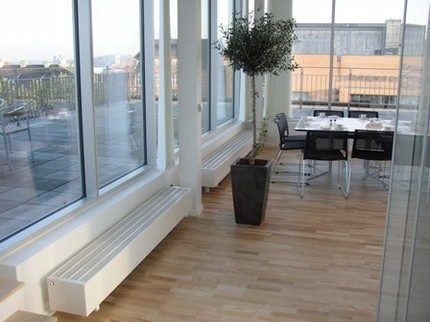
The devices operate on an electric motor that requires direct or alternating current. If the humidity level in the room is above average, it is better to choose electric motors that use alternating current.
Read about the features of selecting electric heating convectors Further.
Compared to other devices, they are more resistant to water. In other cases, it is more advisable to take a convector with a DC motor - it is twice as economical.
Review of the best equipment manufacturers
You definitely cannot buy a floor convector from a dubious company.It is better to opt for products from reliable, proven companies with an optimal price/quality ratio. The brands Jaga, Minib, Polvax, Kermi are characterized by numerous positive reviews.
Kermi is a German company that produces floor convectors with side and bottom connections. The devices operate on different types of convection.
They are equipped with sensitive dynamic regulation, thanks to which the room maintains an average comfortable temperature. Products with a fan are characterized by particularly high power.
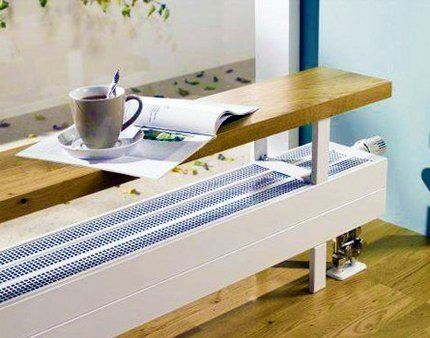
Some models have a built-in thermal radiation screen that minimizes heat loss in rooms with a large glass area by 80%. The devices have a longitudinal or roll-up decorative grille and are made in classic and unusual shapes, emphasizing the individuality of the interior.
The standard color is satin, but upon request the manufacturer produces equipment in any color from the proposed palette.
Jaga is a floor-mounted heating device from a Belgian brand. They are distinguished by decent thermal conductivity and power. The company produces models equipped with a fan unit and standard options that operate on natural convection.
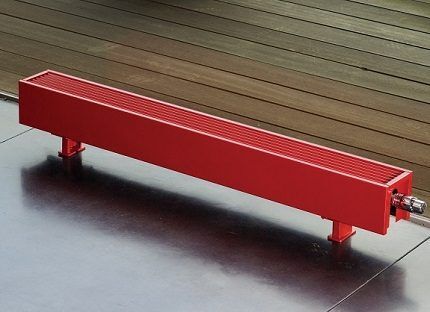
Many of the company's products are equipped with a thermostat and an air release valve.The production uses a special technology that reduces water consumption during operation.
Among the proposals of the Czech company Minib there are heating equipment of various sizes and shapes, heating the space due to natural or forced air convection/
The equipment is made in a strict classic design. There are plenty of color options: you can choose silver, bronze, white and other shades from the palette.
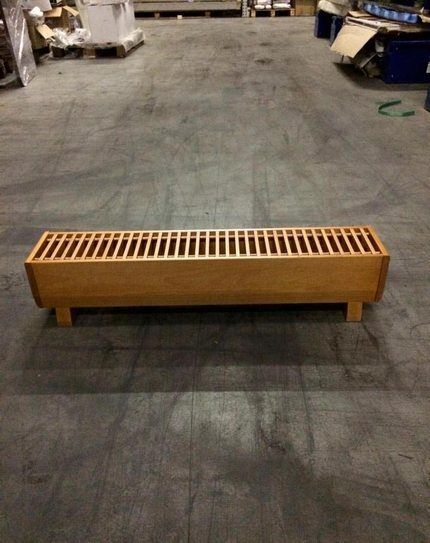
Minib convectors quickly react to a drop in temperature and immediately automatically increase their performance. They can easily heat large residential and non-residential premises.
The main advantage of the products is minimal energy consumption. The range includes a separate model with a thermoelectric generator that does not require power. This is one of the most economical solutions.
Convectors from the famous Polish manufacturer Polvax operate in natural convection mode. The company's assortment includes models with one, two and four heat exchangers made of high-quality copper and aluminum.
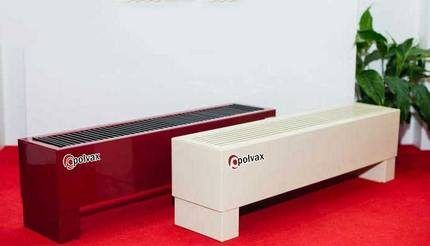
The devices fit perfectly into modern interior styles. Their feature is an enlarged heat exchanger, good thermal power, and affordable cost.
Polvax floor-mounted water convectors heat any room.They are low, so they can be easily installed in rooms with low window sills and large panoramic windows.
Water heating convectors from the Ukrainian manufacturer Carrera are presented in a variety of design variations and sizes.
Devices with forced and natural convection are characterized by high heat transfer, not inferior to European brands.
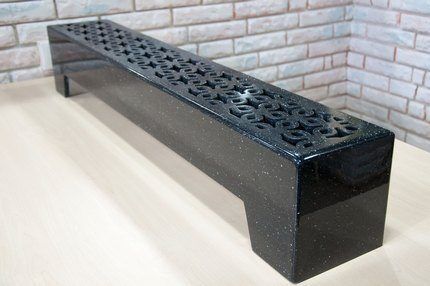
They remove condensate well and can be equipped with a drainage system, which is necessary in bathrooms, swimming pools, greenhouses and other wet areas.
Basic Installation Recommendations
The installation process of a floor convector is quite simple. It is described in detail in the manufacturer's instructions. The equipment is installed on the floor by embedding or mounting on special legs-stands supplied in the kit. It is intended for use in enclosed spaces.
During installation, it is recommended to observe the following rules:
- mount the device in a strictly horizontal position, controlling this with an ordinary building level;
- carefully fix the equipment;
- make sure that the heat exchanger is located on the side farthest from the window (except for the case when the main mission of the convector is to create a protective heat shield along the windows);
- place the device at a distance of 20-25 cm from the floor covering;
- connect the heat exchanger with distribution pipes supplying coolant, flexible hoses with stainless steel coating or metal braided hoses.
- do not allow deformation of the gutter edges.
First of all, the floor surface is marked.Then the legs of the equipment or holders are fixed with special fasteners. After this, the housing is installed and the convector is connected to the water supply system.
Particular care should be taken when installing threaded connections. It is very important not to damage the threads or break the tightness of the clutches. It is best to use a torque wrench in your work, which will allow you not to exceed the tightening torque.
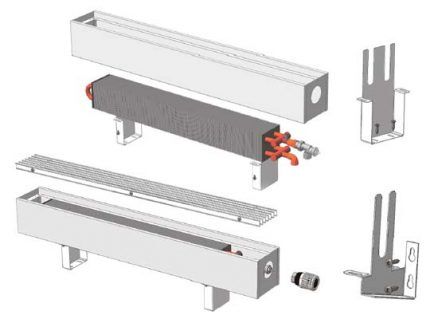
Unlike devices with intra-field and wall mounting type, floor convectors are distinguished by the simplest installation technique. But still, if you have insufficient skills and little experience in handling heating equipment, it is advisable to entrust the installation to a professional technician.
Subtleties of convector care
During operation, the inner surface of the housing and the heat exchanger become contaminated with small particles of dust, crumbs and other household debris. To prevent the device from deteriorating, regular cleaning is recommended.
The procedure does not require much time and effort. It is enough to remove the grille that releases air, and then carefully wipe it with a soft sponge or vacuum the inner surface using a special nozzle.
The top of the body can be wiped down at least every day, but this must be done without aggressive chemical compounds.
Conclusions and useful video on the topic
Visual installation process of a floor convector:
Information about the difference in the efficiency of forced and natural convection, which will help you decide on the choice of device:
A floor-type water convector is a safe, efficient and ergonomic heating method. It can be used in any room without any problems. If you carefully study the instructions with the manufacturer's recommendations, you can save a lot of money and handle the installation yourself.
Do you have personal experience using water floor convectors? Share it with visitors to our site. Tell us which equipment did you prefer? Are you satisfied with his work? Leave comments in the block below the article.




I would advise you to pay attention to convectors built into the floor. They fit perfectly into any interior and are absolutely safe. About comfort and warmth - everything is at the highest level.
Yuri, it depends on what you mean by safe or how others are dangerous? What you would really pay attention to when choosing a trench convector with forced convection is the noise/silence of the fan motor. This is also an excellent solution for country houses where all communications are planned to be hidden. It’s also a plus that the convector grille can be installed to match the interior: use wood, anodized aluminum or powder painting in almost any color of interest.